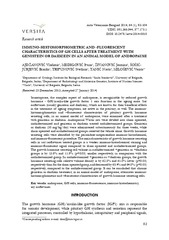Приказ основних података о документу
Immuno-histomorphometric and -fluorescent characteristics of GH cells after treatment with genistein or daidzein in an animal model of andropause
Imuno-histomorfometrijske i –fluorescentne karakteristike gh ćelija nakon tretmana genisteinom ili daidzeinom u animalnom modelu andropauze
| dc.creator | Ajdžanović, Vladimir | |
| dc.creator | Medigović, Ivana | |
| dc.creator | Živanović, Jasmina | |
| dc.creator | Šošić-Jurjević, Branka | |
| dc.creator | Trifunović, Svetlana | |
| dc.creator | Tanić, Nasta | |
| dc.creator | Milošević, Verica | |
| dc.date.accessioned | 2021-08-20T07:48:52Z | |
| dc.date.available | 2021-08-20T07:48:52Z | |
| dc.date.issued | 2014 | |
| dc.identifier.issn | 0567-8315 | |
| dc.identifier.uri | https://vet-erinar.vet.bg.ac.rs/handle/123456789/2145 | |
| dc.description.abstract | Somatopause, the complex aspect of andropause, is recognizable by reduced growth hormone - GH/insulin-like growth factor 1 axis function in the ageing male. Soy isoflavones (usually genistein and daidzein), which are known for their beneficial effects in the treatment of ageing symptoms, are active in the pituitary, as well. The immunohistomorphometric and -fluorescent characteristics of pituitary growth hormone secreting cells, in an animal model of andropause, were examined after a treatment with genistein or daidzein. Andropausal Wistar rats were divided into sham operated, orchidectomized and genistein or daidzein treated orchidectomized groups. Genistein or daidzein (30 mg/kg/day) were administered subcutaneously for three weeks, while sham operated and orchidectomized groups received the vehicle alone. Growth hormone secreting cells were identified by the peroxidase-antiperoxidase immuno-histochemical, and immuno-fluorescent procedure. The main characteristic of growth hormone secreting cells in soy isoflavones treated groups is a weaker immuno-histochemical staining and immuno-fluorescent signal compared to sham operated and orchidectomized groups. The growth hormone secreting cell volume in orchidectomized +genistein or +daidzein groups is by 13.8% and 11.9% (p<0.05) smaller respectively, in comparison with the orchidectomized group. In orchidectomized +genistein or +daidzein groups, the growth hormone secreting cells relative volume density is by 62.5% and 61.0% lower (p<0.05) | |
| dc.description.abstract | Somatopauza, kao kompleksan aspekt andropauze, je prepoznatljiva po sniženom nivou funkcije somatotropne - GH ose kod starih mužjaka. Izofl avoni soje (najčešće genistein i daidzein), imaju blagotvorne efekte pri tretmanu simptoma starenja, a ispoljavaju svoje dejstvo i na nivou hipofi ze. Imuno-histomorfometrijske i – fl uorescentne karakteristike hipofi znih somatotropnih ćelija su ispitivane nakon tretmana genisteinom ili daidzeinom, u animalnom modelu andropauze. Pacovi Wistar soja u andropauzi su podeljeni u nekoliko grupa: prividno operisanu, orhidektomisanu i genisteinom odnosno daidzeinom tretiranu orhidektomisanu grupu. Rastvoreni genistein, odnosno daidzein (30 mg/kg/dan) su potkožno davani tokom tri nedelje, dok su prividno operisana i orhidektomisana grupa dobijale samo rastvarač tokom istog perioda. Somatotropne ćelije su identifi kovane peroksidaza-antiperoksidaza imuno-histohemijskom, i imunofl uorescentnom metodom. Osnovna karakteristika somatotropnih ćelija u grupama tretiranim izofl avonima soje je slabije imuno-histohemijsko bojenje i slabiji imuno– fl uorescentni signal u poređenju sa prividno operisanom i orhidektomisanom grupom. Volumen somatotropnih ćelija u orhidektomisanoj i genisteinom, odnosno daidzeinom tretiranoj grupi je za 13,8%, odnosno 11,9% (p<0,05) smanjen u poređenju sa orhidektomisanom grupom. U orhidektomisanoj i genisteinom, odnosno daidzeinom tretiranoj grupi volumenska gustina somatotropnih ćelija je za 62,5%, odnosno 61,0% niža (p<0,05) nego kod prividno operisane grupe, te za 65,4%, odnosno 64,0% (p<0,05) niža u poređenju sa orhidektomisanom grupom. Može se zaključiti da hronični tretman genisteinom ili daidzeinom, u animalnom modelu andropauze, ima negativan efekat na imuno-histomorfometrijske i – fl uorescentne karakteristike somatotropnih ćelija. | |
| dc.language | en | |
| dc.publisher | Univerzitet u Beogradu - Fakultet veterinarske medicine, Beograd | |
| dc.relation | info:eu-repo/grantAgreement/MESTD/Basic Research (BR or ON)/173009/RS// | |
| dc.rights | openAccess | |
| dc.rights.uri | https://creativecommons.org/licenses/by/4.0/ | |
| dc.source | Acta Veterinaria-Beograd | |
| dc.subject | andropause | |
| dc.subject | GH cells | |
| dc.subject | immuno-fluorescence | |
| dc.subject | immuno-histochemistry | |
| dc.subject | soy isoflavones | |
| dc.title | Immuno-histomorphometric and -fluorescent characteristics of GH cells after treatment with genistein or daidzein in an animal model of andropause | |
| dc.title | Imuno-histomorfometrijske i –fluorescentne karakteristike gh ćelija nakon tretmana genisteinom ili daidzeinom u animalnom modelu andropauze | |
| dc.type | article | en |
| dc.rights.license | BY | |
| dcterms.abstract | Медиговић, Ивана; Милошевић, Верица; Живановић, Јасмина; Шошић-Јурјевић, Бранка; Танић, Наста; Aјджановић, Владимир; Трифуновић, Светлана; Имуно-хистоморфометријске и –флуоресцентне карактеристике гх ћелија након третмана генистеином или даидзеином у анималном моделу андропаузе; | |
| dc.citation.volume | 64 | |
| dc.citation.issue | 1 | |
| dc.citation.spage | 93 | |
| dc.citation.epage | 104 | |
| dc.citation.rank | M23 | |
| dc.identifier.wos | 000341341000010 | |
| dc.identifier.doi | 10.2478/acve-2014-0010 | |
| dc.identifier.scopus | 2-s2.0-84902456818 | |
| dc.identifier.fulltext | https://vet-erinar.vet.bg.ac.rs/bitstream/id/5860/10.2478_acve-2014-0010.pdf | |
| dc.type.version | publishedVersion |

